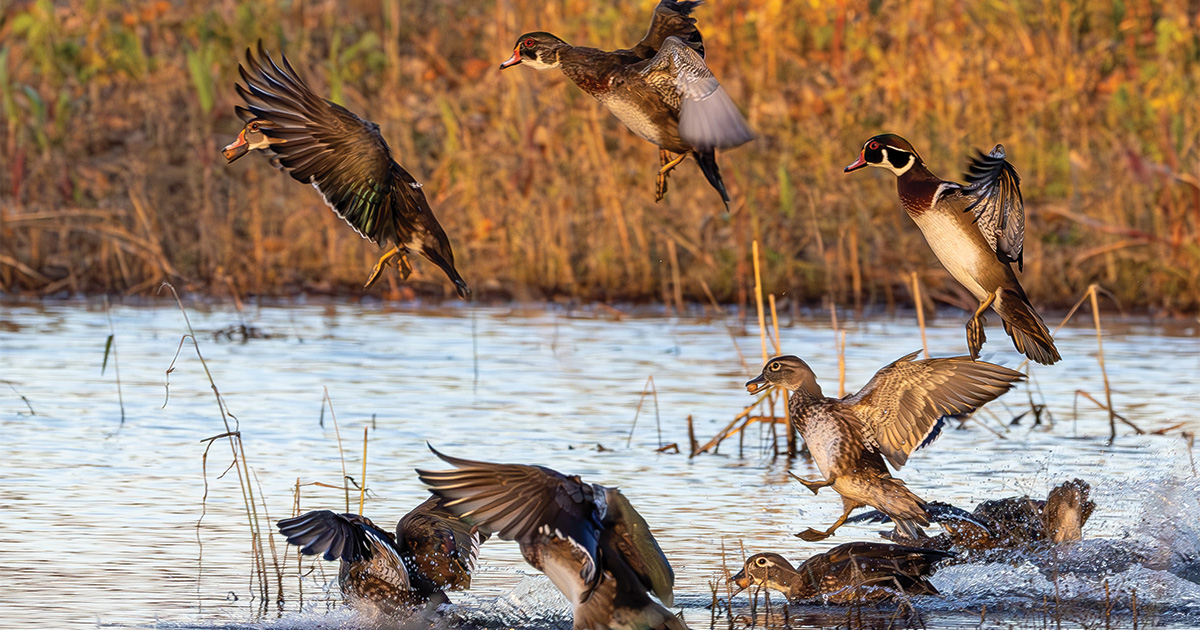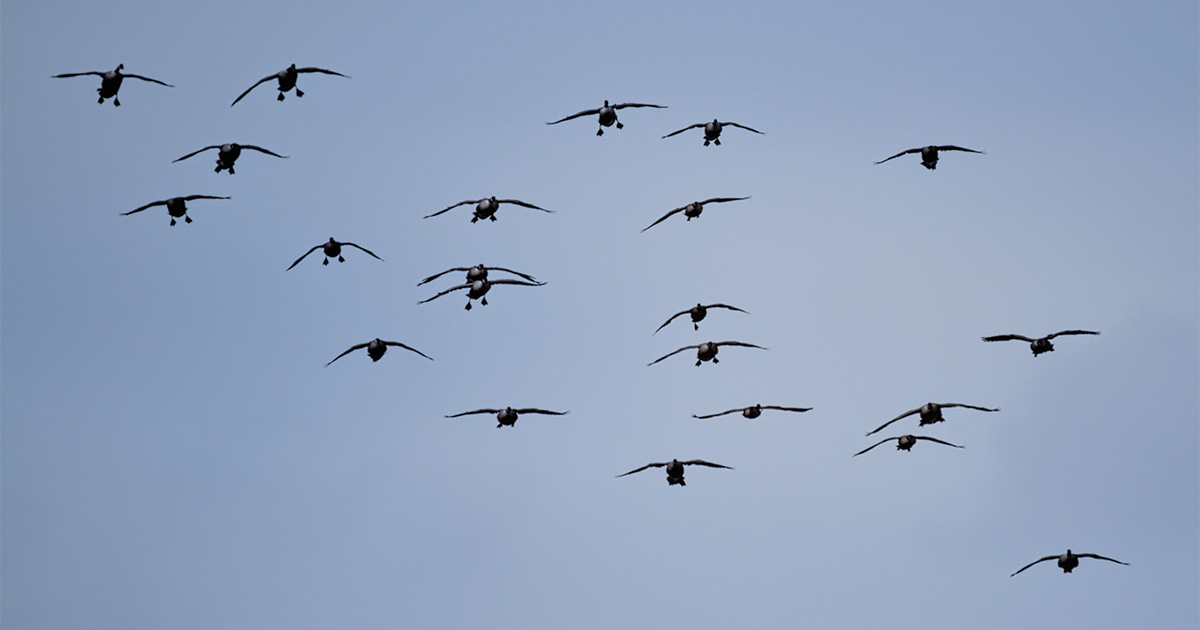Migration Alert: Mixed Habitat Conditions Have Waterfowl Managers and Biologists Optimistic from Delaware to North Carolina
Oct. 2, 2025 – South Atlantic Flyway Preview
Oct. 2, 2025 – South Atlantic Flyway Preview

Waterfowl biologists and land managers around the Mid-Atlantic region and Chesapeake Bay sound guardedly optimistic as the 2025–26 waterfowl season begins. Rainfall fluctuations and wetland conditions have yielded a bit of a mixed bag across the region. Here’s a look at current conditions from Delaware to North Carolina.
Habitat in Delaware is faring better than last summer and fall, according to Cole Tiemann, Delaware Division of Fish and Wildlife (DDFW) waterfowl and migratory gamebird biologist. Still, August and September have been very dry and Tiemann has seen some inland wood duck habitats deteriorate. Brief precipitation events haven’t been enough, he explains. “Based on our banding and observations, I think wood ducks had a good production year, and geese were average to good.”
James Joachimowski, DDFW impoundment and habitat biologist, says Delaware’s many state-owned coastal impoundments remain wet and partially flooded, ready for migrating birds. These impoundments are scattered statewide within wildlife areas. Impoundments in northern Delaware are better suited to manage freshwater vegetation. Joachimowski says these areas have had ideal growth of wetland vegetation after strategic water-level drawdowns. While a few mid-state impoundments are managed for freshwater and dependent on rainfall, most in this region are brackish, with tidal flooding, and managed for invertebrates and submerged aquatic vegetation (SAV).
“These areas should host a variety of waterfowl species in the months to come,” Joachimowski says. “Recent upgrades to water-control structures on impoundments in the Assawoman Wildlife Area have helped maintain water levels in this saltwater environment.”
Jake McPherson, DU managing director of development, worries that the mostly dry summer could limit the availability of wetland habitat as waterfowl begin to arrive in Maryland. “This could result in localized concentrations of ducks in the early season centered around managed wetlands that have water,” McPherson says. “On the flip side, we had a very wet spring, and those freshwater inputs—and the sediment and nutrients carried with them—undoubtedly impacted SAV in the bay. I heard that SAV in the lower section of the bay was strong, but in the mid-bay, acreages were down significantly. I suspect the variable habitat conditions will definitely have an impact on waterfowl distribution this fall.”
Kayla Harvey, waterfowl project leader for the Maryland Department of Natural Resources (MDNR), has heard reports of successful hunts during the early resident goose season, but only a few reports of ducks in the area during the early teal season. Rainfall in spring and early summer seem to have bolstered the wood duck hatch.
“We banded good numbers of juvenile birds during late-summer banding operations,” Harvey says. “However, some freshwater habitats are still dry following drought this past winter and early spring. Similar to most years, we are hopeful for rain and a strong cold front to push birds south for the regular waterfowl seasons. Atlantic Population Canada geese should begin to arrive soon, with larger groups arriving later in the fall.”

Virginia Department of Wildlife Resources Waterfowl Biologist Ben Lewis calls habitat conditions “variable statewide,” noting, “Most areas were very dry; the Eastern Shore received some very timely and significant rainfall in September that should help with habitat conditions. But a lot of areas are still well below average rainfall for the year.”
Lewis reports that early season teal hunters had limited success, but he believes Virginia had a good resident Canada goose hatch. “I’ve heard good reports from many hunters,” Lewis says. Wood ducks are another story he explains. “Anecdotally, from our banding work, I think the wood duck hatch was average at best.”
Ed Farley, DU manager of conservation programs, gets around, especially in North Carolina. He says local wood ducks and goose numbers are about average in the Tarheel State, with blue-winged teal arriving in good numbers.
“As far as habitat conditions are concerned, we had a wet spring and early summer, but things have dried out since. We have been very dry the last few weeks, which may make it difficult to flood wetlands for the early season, but spotty showers have made a difference in some small areas.” Farley says. “Wetland conditions appear good overall. If we get weather and water, the early part of the season could be good.”
Hunter Morris, waterfowl biologist with the North Carolina Wildlife Resources Commission, echoes the weather observations. “The second half of summer into early fall here has been abnormally dry across the entire state with a large portion of the coastal plain experiencing moderate drought conditions,” Morris says.
Wet conditions earlier this year created good wood duck brooding habitat in the swamps. “We saw this reflected with strong numbers of hatch-year birds being marked during the preseason banding period. So, if nothing else makes it down this year, there should still be plenty of wood ducks around,” Morris says.
Another upside, Morris points out, is that the waters of the Atlantic Coast, including North Carolina’s saltwater sounds, provide plenty of opportunity while other areas may lack water.
Morris says North Carolina’s resident goose population remains stable at around 150,000 birds, providing ample hunting opportunities in the zone approved for resident birds. “It looks like folks have been taking full advantage of the September season based on the band returns coming in,” he adds.
Finally, North Carolina’s coastal federal wildlife refuge network is often a magnet for migrating birds. Brian Van Druten, fish and wildlife biologist at the Alligator River and Pea Island National Wildlife Refuges, says SAV in Pea Island’s three impoundments looks good, thanks to the ability to pump water during the summer drought. “We are starting to see some migrating species such as blue-winged teal and northern pintails. More than 1,000 northern pintails and approximately 150 blue-winged teal arrived at Pea Island in just the last week.”
At Alligator River National Wildlife Refuge, a few impoundments produced decent crops of rice, sorghum, and corn, but production in other impoundments was challenging. Fortunately, native waterfowl foods, including foxtail, smartweed, fall panicum, and yellow nutsedge sprouted in abundance.
Stay up to date with the latest migration information.
Ducks Unlimited uses cookies to enhance your browsing experience, optimize site functionality, analyze traffic, and deliver personalized advertising through third parties. By continuing to use this site, you agree to our use of cookies. View Privacy Policy